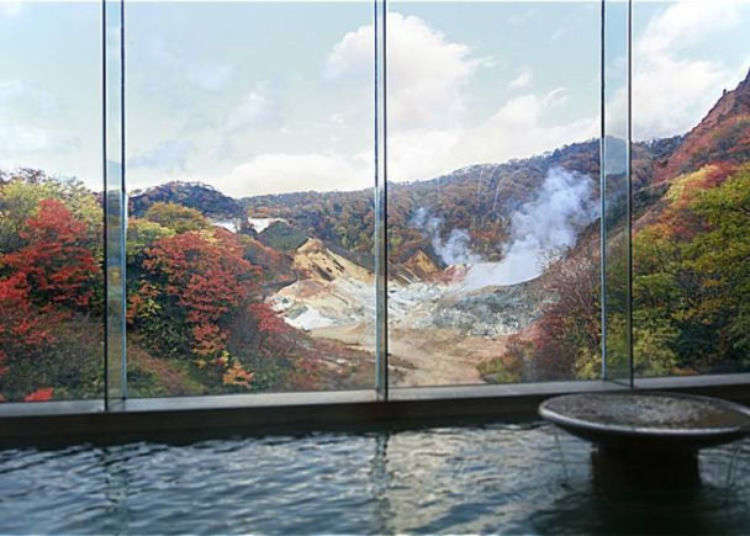
The Dai-ichi Takimotokan Hotel is a well-established inn in Noboribetsu Onsen. Its hot spring baths are fed by geothermal water from five springs having half of the ten mineral qualities of spring water found in Japan.
You can enjoy the view of Hell Valley, a popular sightseeing spot while relaxing in the hotel's Onsen Heaven. Here we'll introduce all the charms of the magnificent Dai-ichi Takimotokan Hotel!
- Table of Contents
-
- Dai-ichi Takimotokan Hotel: Onsen Heaven Next To Hell Valley
- Half of the 10 types of mineral water in Japan can be found at Dai-ichi Takimotokan Hotel!
- Water quality in Dai-ichi Takimotokan's many baths is maintained through experience and craftsmanship
- Enjoy your time eating, shopping, and sipping the spring water during your stay
Dai-ichi Takimotokan Hotel: Onsen Heaven Next To Hell Valley

Dai-ichi Takimotokan Hotel is next to Hell Valley, a famous sightseeing destination in Noboribetsu Onsen, a hot spring resort area located about an hour's drive from the New Chitose Airport. Established in 1858, it has the oldest history of any hot spring inn in Noboribetsu Onsen.
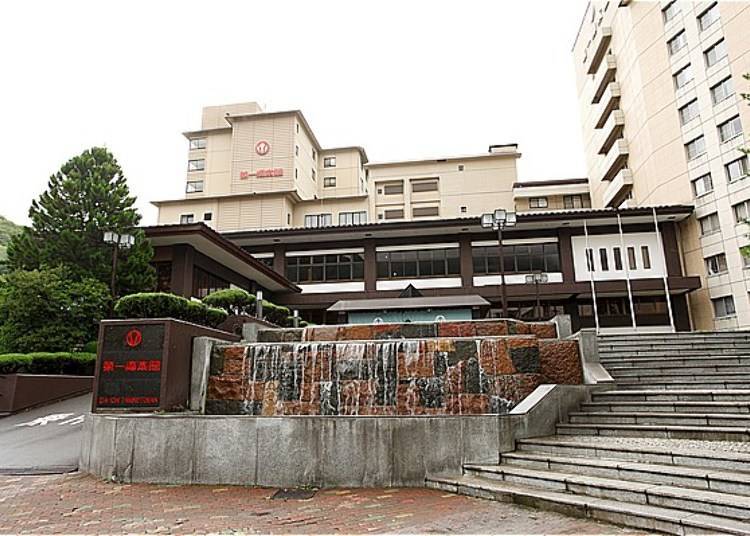
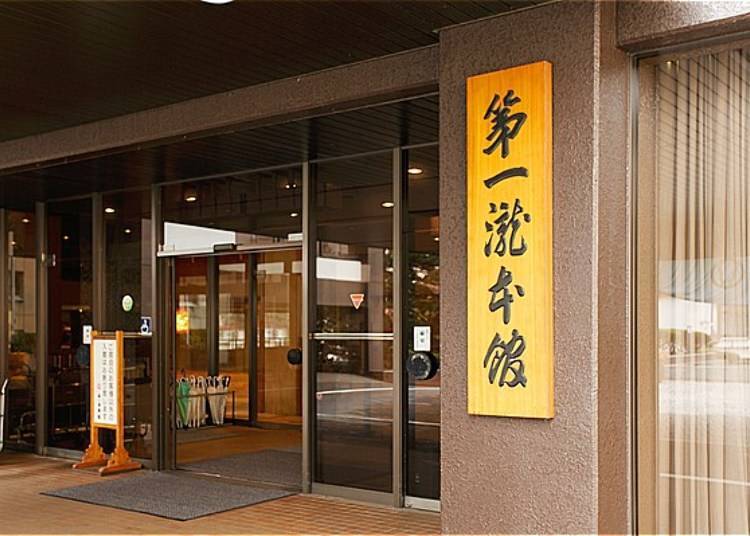

The founder, Kinzo Takimoto, heard about a natural hot spring in the mountains that effectively treated skin maladies. His wife had a severe skin disorder, so he took her deep into the mountains and built a small hot spring cottage.
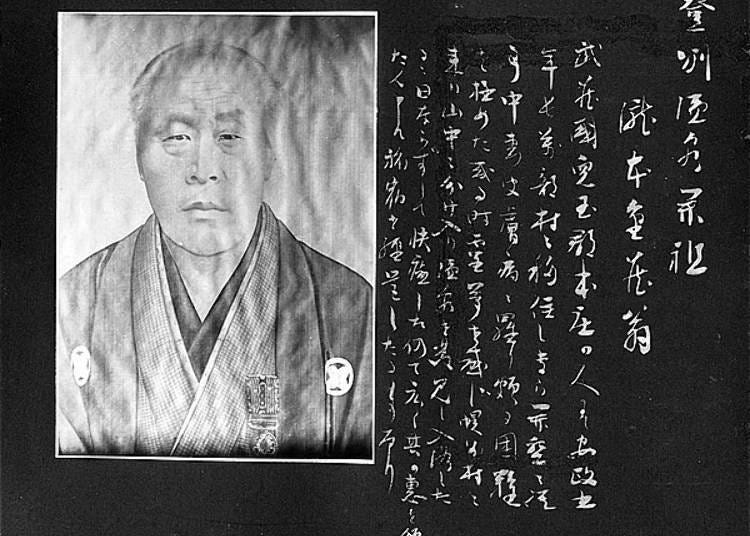
The beneficial effects soon became apparent in his wife, who grew better day by day.
Word spread of the hot spring's healing powers, which led to the building of a hot spring inn and the start of his spa operations. As rumors spread even more widely about the beneficial effects, the number of visitors steadily increased, which led to continued renovation and expansion of the inn.
This, in turn, led to roads being built to the spring to enable horse-drawn carriages to reach it. And this laid the groundwork for the development of Noboribetsu Onsen.
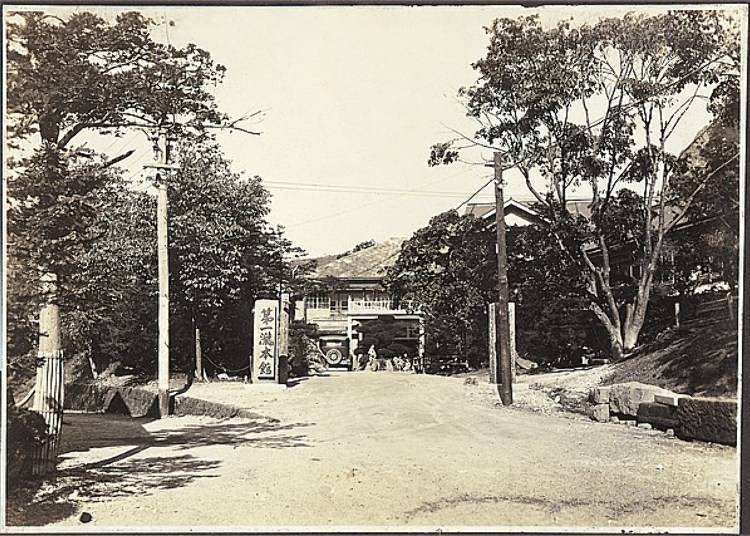
Today about 2.8 million people visit Noboribetsu Onsen for sightseeing every year. It all began with the Aisai no Yu hot spring built for the wife of Kinzo Takimoto, founder of the Dai-ichi Takimotokan.
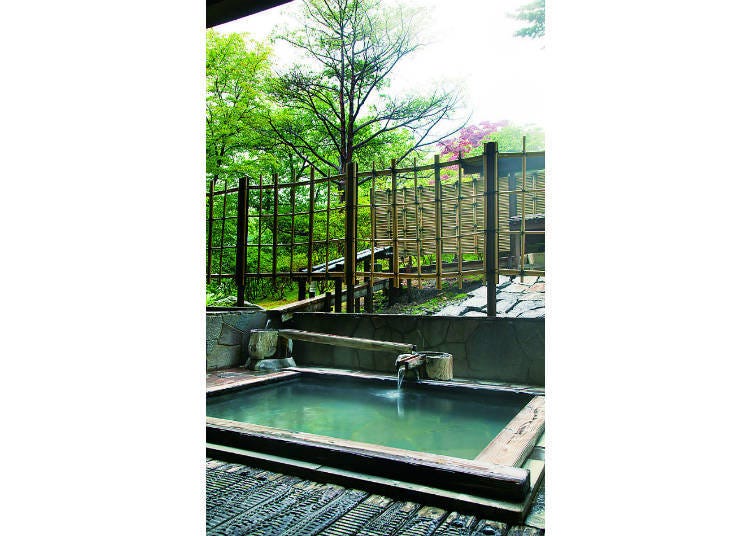
The water quality of the Kinzo no Yu is slightly green in color due to its acidity. This is very good for skin conditions and can be enjoyed in the outdoor bath and other indoor baths, too.
Half of the 10 types of mineral water in Japan can be found at Dai-ichi Takimotokan Hotel!
There are still more types of mineral water to be enjoyed at Dai-ichi Takimotokan Hotel!
The main features of Dai-ichi Takimotokan are the various types of mineral water, such as in Kinzo no Yu, and the large volume of water the springs produce. Five different types of mineral water flow from their sources in Hell Valley into the 35 baths for men and women inside the 5,000 square meters three-story hot spring annex.
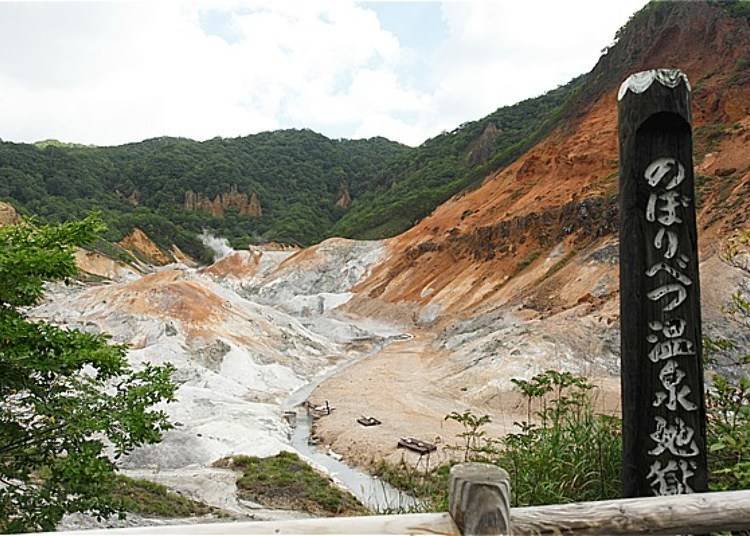
The representative mineral quality of the springs in Noboribetsu Onsen is such that visitors are certain to find the type they have been looking for. This white, ash color bath smells of hydrogen sulfide and is reported to be especially good for skin and female conditions. It is a sulfur spring.
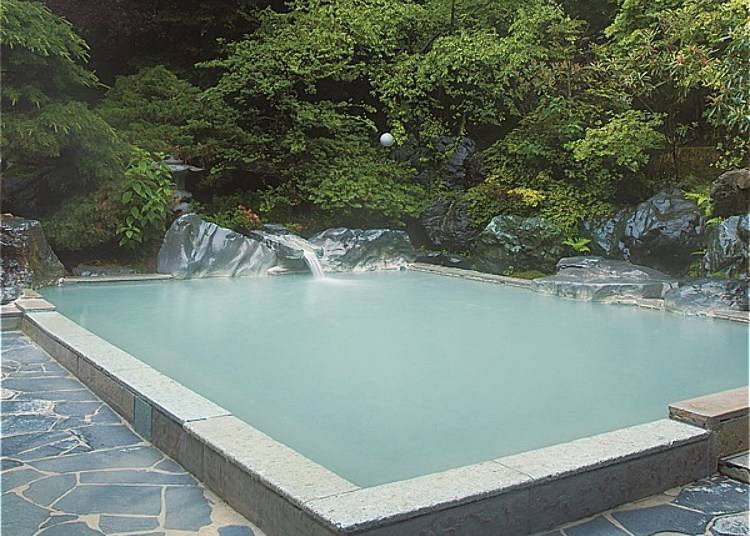
The sulfur components give the bath its milky color. It is reported to be very good for external injuries and skin disorders (Glauber’s salt spring). After soaking for a while in the bath, your body will smell like sulfur when you get out.
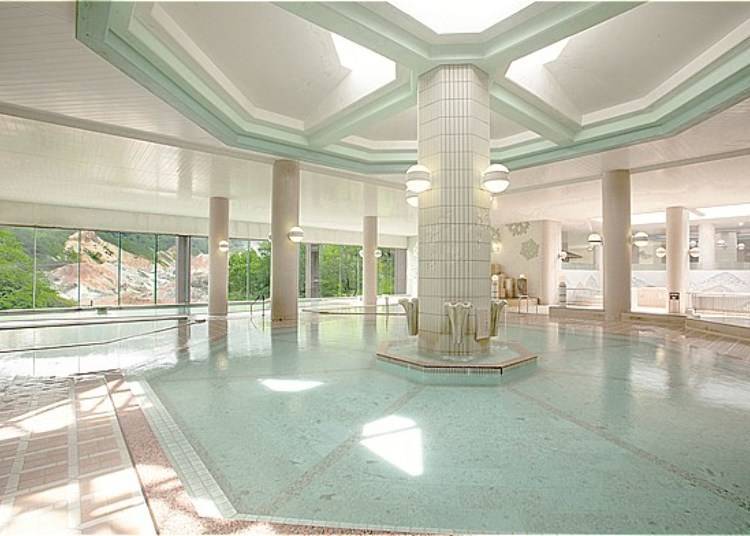
After enjoying the strong acidic compositions of such baths as the Bihada-no-Yu and Kizu-no-Yu, try a bath having a more neutral alkaline content. The Shokuen-sen (table salt spring) is rich in sodium and said to be good for neuralgia and sensitivity to the cold, being gentle to the skin.
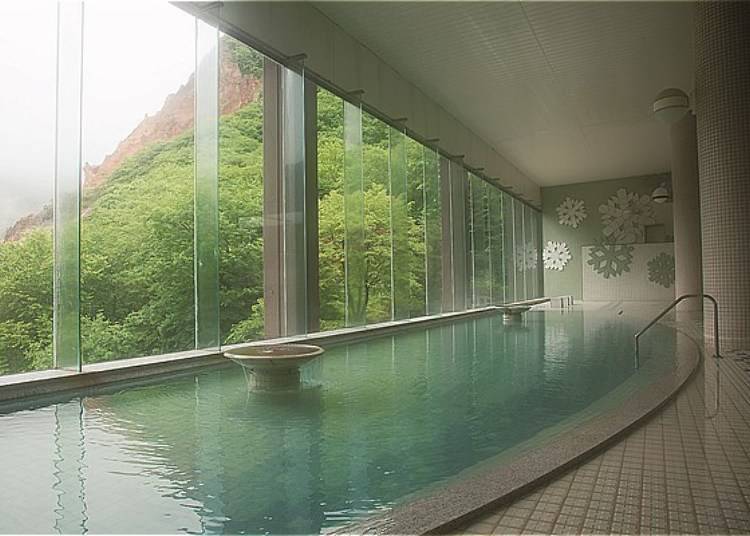
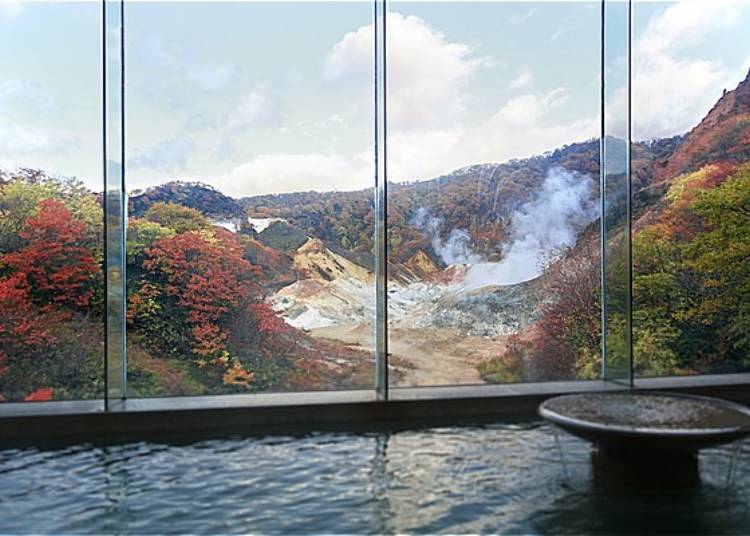
The tub of the Shokuen-sen bath is made of Japanese cypress, which is soft to the skin and imparts an aromatic aroma of cypress. The temperature of the water is set slightly high at 45 degrees.
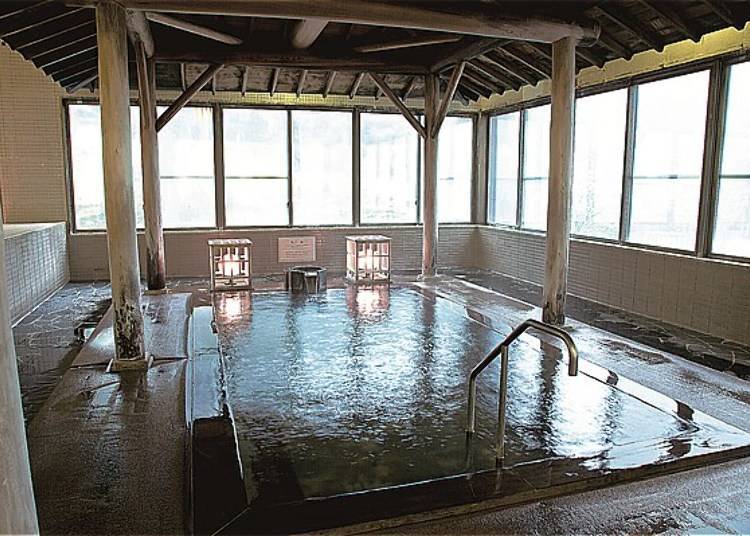
There are other baths in addition to the ones already mentioned, such as the Sansei Midoriban-sen bath, which effectively treats atopic dermatitis and the Juso-sen (baking soda spring) is popular for making horny skin soft and smooth. There are indoor men’s and women’s bath for each.
There are hot spring baths having different mineral compositions scattered throughout, so why not spend a day or two exploring all of them?
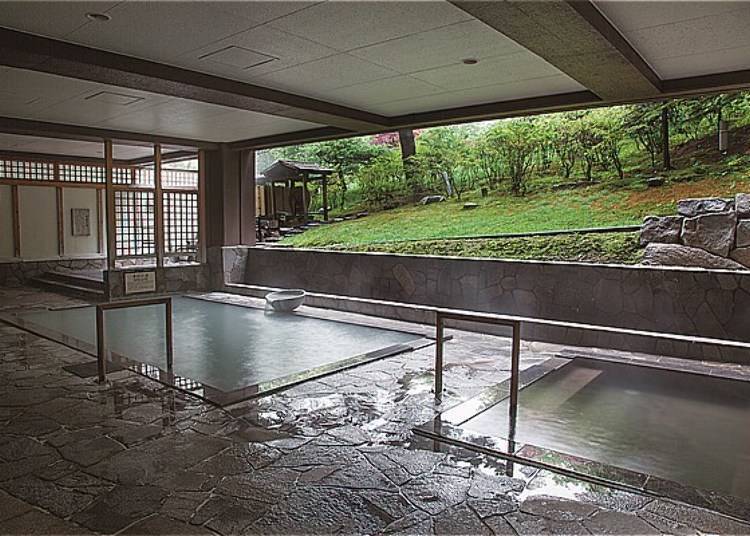
Dai-ichi Takimotokan has many types of baths in different shapes and sizes for your enjoyment. The baths' temperature is controlled by the flow of natural hot spring water and not through recirculation. These natural hot springs are another one of Nature’s bounties!
Water quality in Dai-ichi Takimotokan's many baths is maintained through experience and craftsmanship

The Yumori (people who maintain the baths) are indispensable for keeping the many baths with their different mineral components in good condition.
Besides cleaning the mineral sediment that collects in the baths, Yumori are also responsible for maintaining the constant water temperatures in the baths and the volume and flow from the hot springs.
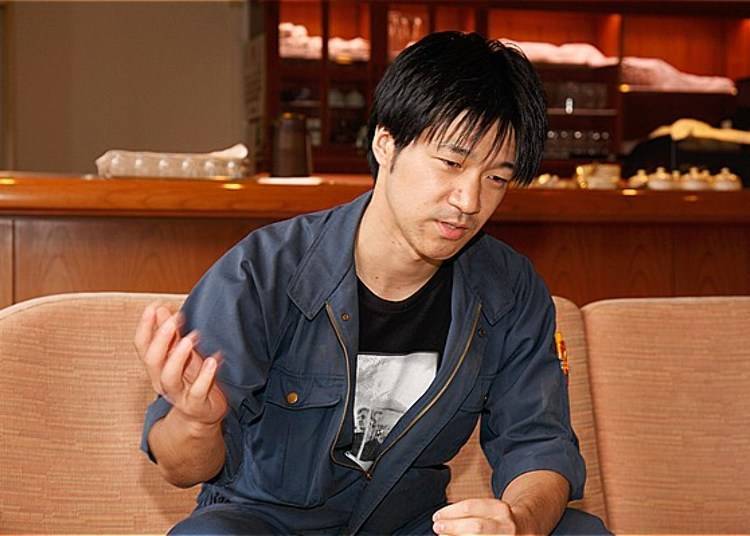
Mr. Arukimachi said the hardest part of his job is maintaining the proper water temperature in the baths. The hot springs flow naturally, so the flow and heat are not the same for them all.
For example, when it rains for several days, the spring water temperature drawn from Hell Valley is lower than usual, and after several sunny days, it becomes hotter.

None of the Dai-ichi Takimotokan baths are artificially heated, so when the temperature of a bath drops below what it should be, more natural hot spring water is fed into it until the proper temperature is again reached, and sometimes that can take much time.
The duties of the Yumori requires years of experience and specialized skills to keep the seven types of 35 baths in perfect order.
Enjoy your time eating, shopping, and sipping the spring water during your stay

![[Top] The “Loving Wife pot made with Hokkaido-raised beef” and tender Hokkaido-grown corn in a broth made from the baking soda spring water [Bottom] A Loving Wife dish of Tokachi beef steamed with water from the baking soda spring. The ingredients are very tender. Both dishes are prepared at the Dai-ichi Takimotokan (Photo: Dai-ichi Takimotokan)](https://rimage.gnst.jp/livejapan.com/public/article/detail/a/10/00/a1000027/img/en/a1000027_parts_5b23186781935.jpg?20201202194934&q=80)
Of course, the greatest pleasure of visiting a hot spring resort is in taking the baths, but one should also enjoy the cuisine offered. The buffet at the Dai-ichi Takimotokan provides a variety of dishes made with seasonal ingredients.
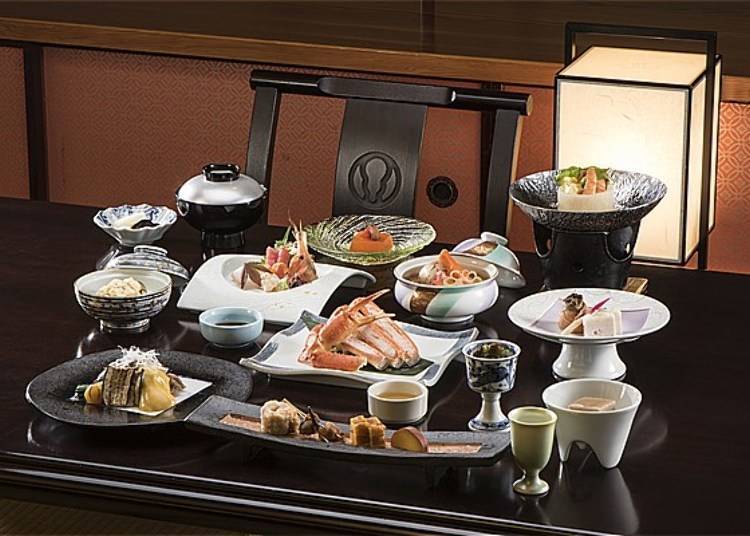
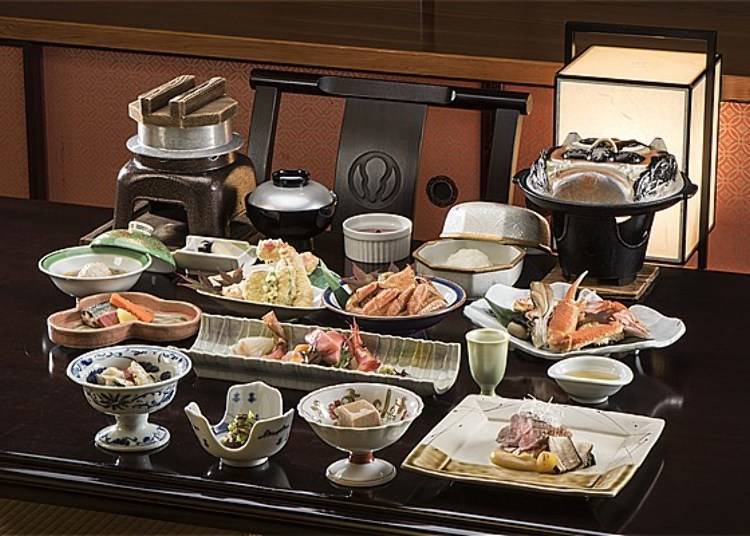
You can also have these exquisite courses served in your room or enjoy them in a banquet room.
The Grand Buffet offers a wide selection of dishes for your dining pleasure.
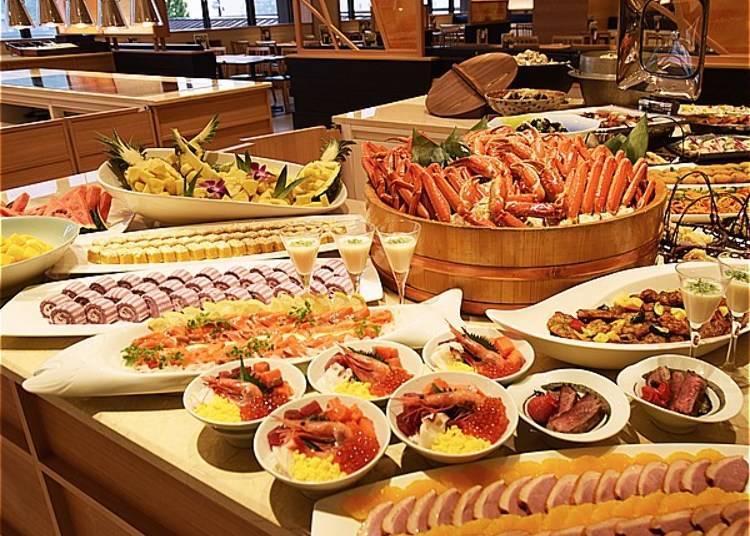
The Wakuwaku-don is especially popular: a bowl of rice upon which you can put any of your favorite ingredients.
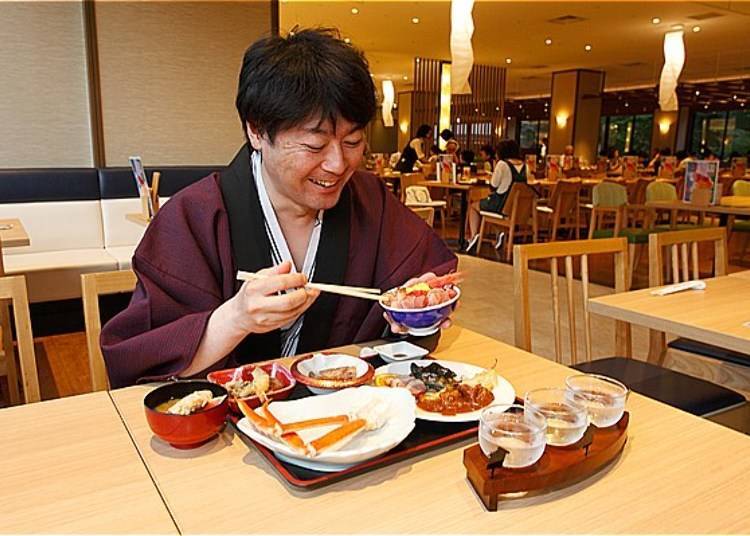
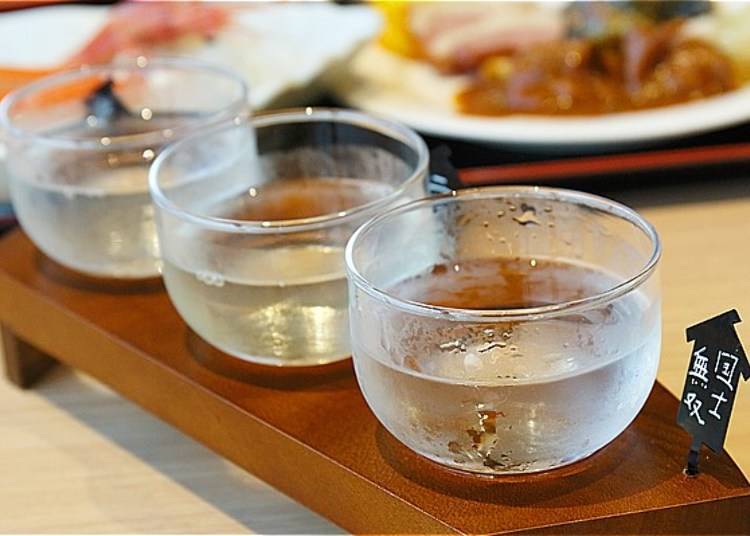
After a hearty meal relax a bit back in your room and then either head to the baths again or go shopping!
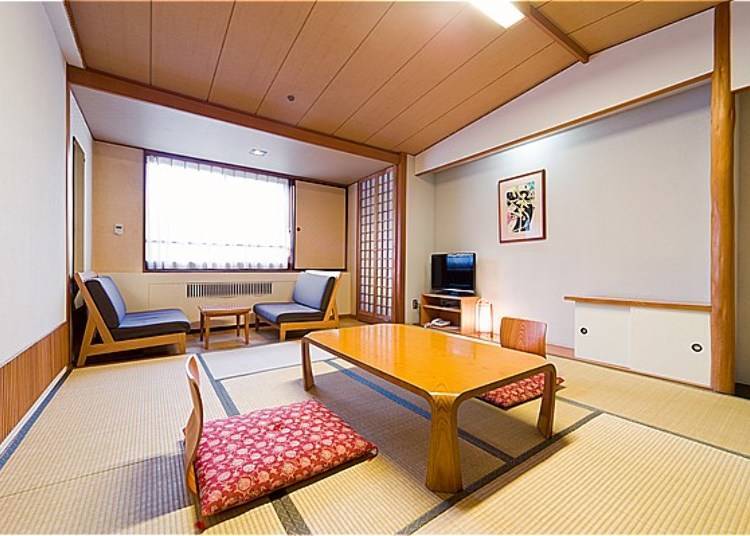
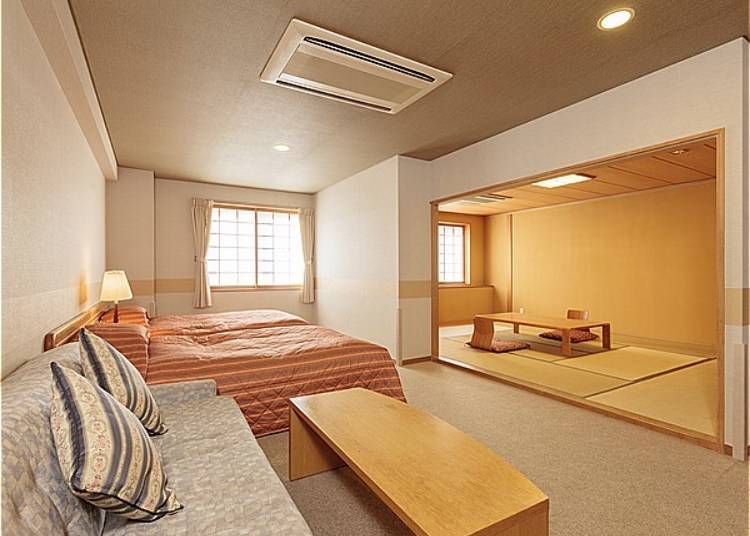
The Yu no Machi gift shop is a short distance from the front desk and offers a selection of souvenirs and gifts. There is a large stairwell before it.
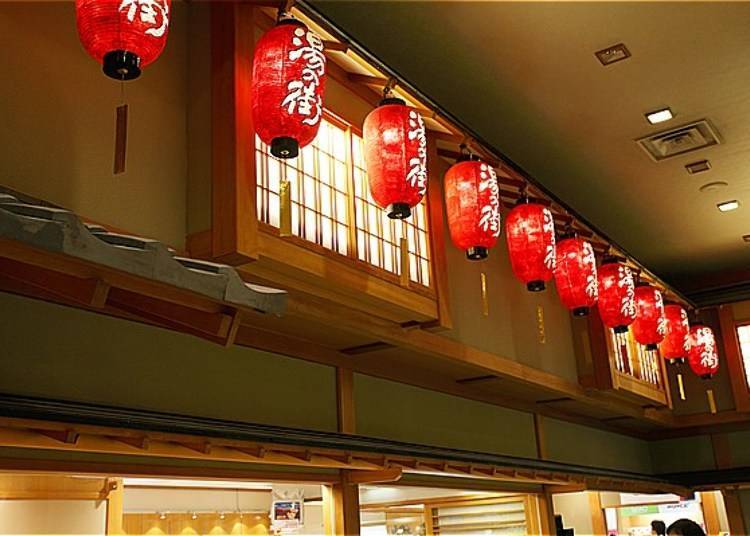

Continuing for another three or four minutes, you will arrive at the passageway leading to the hot springs annex. Just before entering the annex, there is a spot where you can sample mineral water from the springs.

After that, you can enjoy lounging in the many baths to your heart’s content.
There are more baths in the Onsen Heaven facing the expanse of Hell Valley than you can enjoy in a single day. Start with the Loving Wife bath and enjoy as many more of the well-kept baths as you can.
-

-
Address
55 Noboribetsu Onsencho, Noboribetsu-shi, Hokkaido, 059-0595
View Map -
Nearest Station
Noboribetsu Station (Muroran Main Line)
-
Address
55 Noboribetsu Onsencho, Noboribetsu-shi, Hokkaido, 059-0595
Written by : Nobuhiro Kawashima
*Prices and options mentioned are subject to change.
*Unless stated otherwise, all prices include tax.
Popular Tours & Activitiess
Recommended places for you
-

Sapporo Clock Tower
Landmarks
Sapporo / Chitose
-
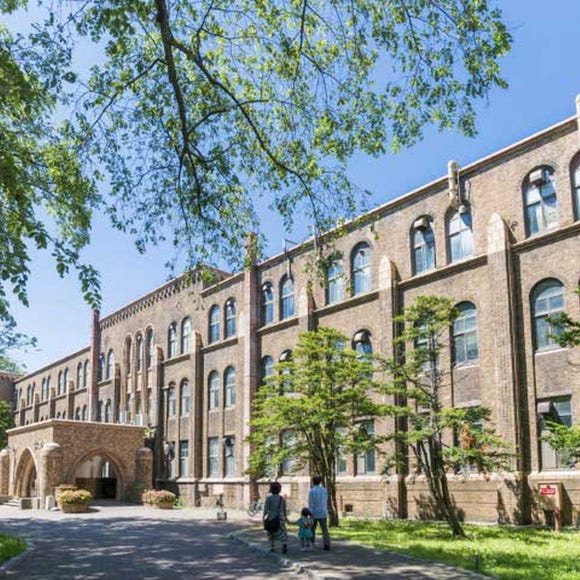
Hokkaido University
Other Architecture
Sapporo / Chitose
-
Appealing

Rukku and Uohei
Izakaya
Sapporo / Chitose
-
Appealing

Shirogane Blue Pond (Aoiike)
Rivers, Lakes & Canyons
Furano / Biei / Sounkyo
-
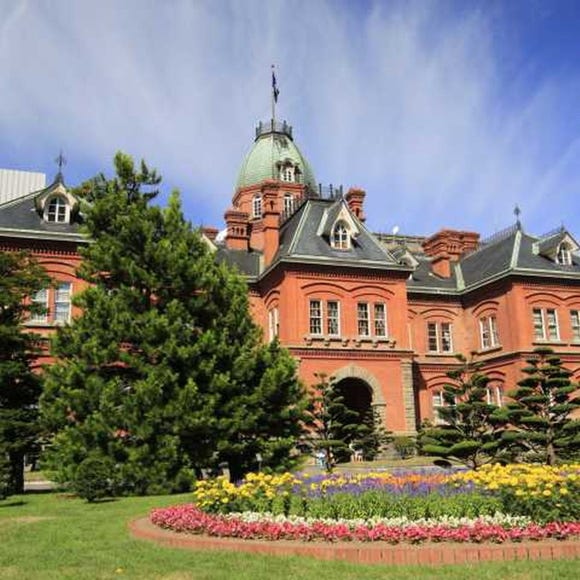
Former Hokkaido Government Office Building (Red Brick Office)
Other Historic Sites
Sapporo / Chitose
-
Appealing

Odori Park
Parks
Sapporo / Chitose
-

Expert-Recommended: 9 Hakodate Hotels Serving Up the Best Breakfasts in Town
by: Nobuka Kawashima
-

BIGGEST SALE ALERT! SATUDORA Tax-Free Winter Sale: Stack Coupons for Massive Savings!
by: Guest Contributor
-

Beyond Hakodate and Matsumae: Enjoy the Hidden Gems of Hokkaido’s Donan Area
-

Great Local Eats: 5 Expert-Recommended Local Chain Restaurants in Hakodate
by: Nobuka Kawashima
-
Ad

Sapporo SATUDORA Shopping Guide: Get Souvenirs, Medicine & More at This Iconic Drugstore (Special Deal Inside!)
-

7 Iconic Hokkaido locations that will make your Instagram shine
by: Himanshi Shah
-

Best Onsen in Japan: Popular Hot Springs Destinations Japanese People Can't Get Enough Of
by: Ran Tanaka
-

Discover Jozankei Onsen: Top Ryokan & Activities in Sapporo's Hot Springs Retreat
by: Nobuka Kawashima
-

Autumn in Japan 2025: Fall Foliage Forecast & Where to Enjoy the Colorful Leaves (+Tour Info)
-

Top 5 Things to Do in Hokkaido's Biei and Furano Area: Shirogane Blue Pond, Lavender Fields, And More!
-

Otaru Travel Guide: Inside Hokkaido's Leading Destination (Sightseeing, Food, and Shopping Tips)
-

3 Gorgeous Onsen in Niseko: Soaking Spots in Japan's Wild North
- #best sushi hokkaido
- #things to do hokkaido
- #best ramen sapporo
- #what to bring to japan
- #new years in tokyo
- #what to buy in ameyoko
- #japanese nail trends
- #what to do in odaiba
- #onsen tattoo friendly tokyo
- #daiso
- #best sweets otaru
- #japanese fashion culture
- #best nature furano
- #japanese convenience store snacks
- #best japanese soft drinks















